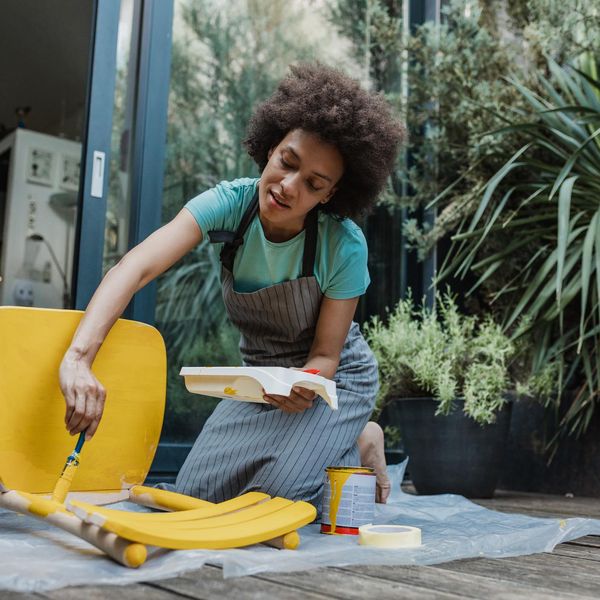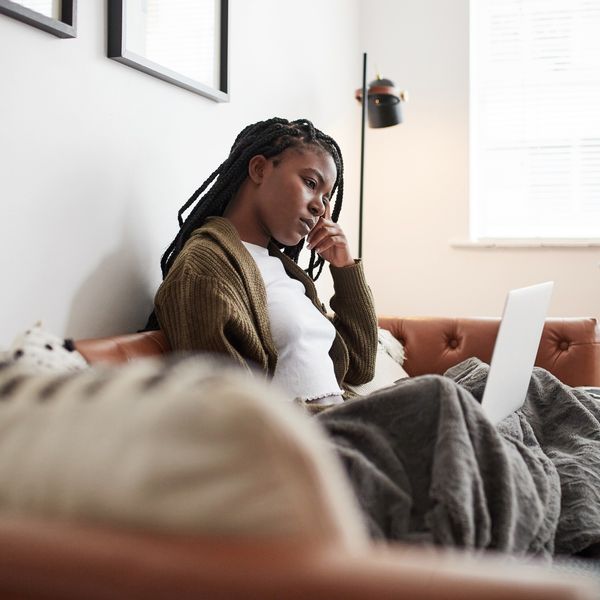
There's always talk about creating a side hustle and having multiple streams of income, but what happens when you're already super-occupied, booked, blessed, and busy with the 9-to-5 you have on top of other responsibilities like managing a household, pursuing higher education, or loving on bae? Well, one of the best ways to leverage a great side hustle opportunity is to look into monetizing things you already do as hobbies.
There are several ways you can turn a hobby into a lucrative business. Try these steps to get started:
First, make sure your hobby is something you actually want to be obligated to do for money.
Listen, as much as I love putting together a good wig or two for myself (and can spend hours on YouTube watching videos about hair care and wig-making) I certainly am not interested in making them for others. There's that obligation-to-a-customer factor that deters me. I like doing it for the love and outlet, not for paying customers who will demand more and more.
If your hobby is something you do solely for your own self-care or as a method to facilitate mental and physical wellness, you might want to think twice about monetizing it.
Be sure the hobby you choose to monetize is something that you love offering to others and that you're committed to consistently doing, on a daily, weekly, or monthly basis, for an actual profit. If you can't see yourself, for example, creating artwork for multiple patrons or clients and only draw or paint when you feel the urge, creating a whole business (or even a side hustle) around that is probably not the best move.
Showcase your hobby on social and use it as free marketing.
Listen, if you're great at scrapbooking, making T-shirts, doing nails, launching events, or cooking, and you want to start doing these things for money, a great place to start getting potential customers via social. Start posting great videos and images about your process or product and going Live on Facebook, YouTube, Instagram, or LinkedIn. (Yes, there's an option there, and to be honest, that's where there are probably more paying customers and investors than you'd think.) Slowly and consistently (i.e. at least 3 times per week) introduce your followers to your hobby and don't assume people just knew you could do it so well.
Then start to market after connecting with both your current and your new audience (or "followers"). Start letting them know what you offer, having a call-to-action (such as "Connect with me on my website for my cooking services" or "Visit my Facebook page to find out about the next event") in order to draw people in and grab your first paying clients or customers.

Morsa Images/Getty Images
Start small, then scale bigger.
Oftentimes when people think about starting a business or side hustle, they have these grand visions of what that actually looks like. (Trust me, I've consulted small business owners and founders for years, and this is a common occurrence.) With any new process or endeavor, you can think big but start small.
For example, if you love making jewelry, instead of trying to make a whole line of rings, necklaces and bracelets, stick to one item at first, cultivate a community, track the growth of your customer base, create a good marketing plan, and then launch more when the time is right (i.e. you've actually gained traction in the market, are making a profit, or can see things working or not working when it comes to actually making money from doing so). Once you're able to see success and build up a cult following, for say, custom necklaces, you can then launch a new or related line of other jewelry.
(This is what's meant by scaling. It helps you to avoid burnout and can oftentimes save you the disastrous occurrence of either totally flopping early with your product or service or not being able to accommodate a surge of customers due to sudden popularity, a viral video, or news coverage that put your brand on the map.)
Test out your product or skill among your network.
And no, I'm not talking about family and friends because, sadly, sometimes they're the last to actually buy anything or pay an invoice for services. I'm talking about your college alumni association, your co-workers, your former employers, or your church.
Your true potential customer is your neighbor, your hair salon tribe, folk you meet at conferences, or the women who are quick to book those group trips. I'm talking about the folk who actually like and comment on your Instagram Reels or TikTok videos showcasing your skills or work.
You might want to test out your hobby at a low cost (or even for free) and ask for feedback via Google Forms or another method. Get real and honest feedback about what you're offering and find ways to leverage that to not only improve your method, product, service, or process but to make that person (or organization) your next paying customer.

Lighthouse Films/Getty Images
Book a session with a consultant.
If you find yourself overwhelmed with all the steps it might take to turn your hobby into a business, hire someone to help you. There are many qualified, amazing coaches and consultants who can not only guide you through the process but help you create plans to manage your time so that you can accomplish your goal of doing something you love and making a profit.
Tap into all the resources afforded to you online or in-person in order to turn a passion into a lucrative business. Hey, you never know: That hobby might someday be the thing you were destined to do to serve and slay all along, profit or not.
Let’s make things inbox official! Sign up for the xoNecole newsletter for daily love, wellness, career, and exclusive content delivered straight to your inbox.
Featured image by blackCAT/Getty Images
- Here Are Three Money Moves You Can Make During The Self ... ›
- This Six-Figure YouTuber Educates Women On How To Make ... ›
Eva Marcille On Starring In 'Jason’s Lyric Live' & Being An Audacious Black Woman
Eva Marcille has taken her talents to the stage. The model-turned-actress is starring in her first play, Jason’s Lyric Live alongside Allen Payne, K. Michelle, Treach, and others.
The play, produced by Je’Caryous Johnson, is an adaptation of the film, which starred Allen Payne as Jason and Jada Pinkett Smith as Lyric. Allen reprised his role as Jason for the play and Eva plays Lyric.
While speaking to xoNecole, Eva shares that she’s a lot like the beloved 1994 character in many ways. “Lyric is so me. She's the odd flower. A flower nonetheless, but definitely not a peony,” she tells us.
“She's not the average flower you see presented, and so she reminds me of myself. I'm a sunflower, beautiful, but different. And what I loved about her character then, and even more so now, is that she was very sure of herself.
"Sure of what she wanted in life and okay to sacrifice her moments right now, to get what she knew she deserved later. And that is me. I'm not an instant gratification kind of a person. I am a long game. I'm not a sprinter, I'm a marathon.
America first fell in love with Eva when she graced our screens on cycle 3 of America’s Next Top Model in 2004, which she emerged as the winner. Since then, she's ventured into different avenues, from acting on various TV series like House of Payne to starring on Real Housewives of Atlanta.

Je-Caryous Johnson Entertainment
Eva praises her castmates and the play’s producer, Je’Caryous for her positive experience. “You know what? Je’Caryous fuels my audacity car daily, ‘cause I consider myself an extremely audacious woman, and I believe in what I know, even if no one else knows it, because God gave it to me. So I know what I know. That is who Je’Caryous is.”
But the mom of three isn’t the only one in the family who enjoys acting. Eva reveals her daughter Marley has also caught the acting bug.
“It is the most adorable thing you can ever see. She’s got a part in her school play. She's in her chorus, and she loves it,” she says. “I don't know if she loves it, because it's like, mommy does it, so maybe I should do it, but there is something about her.”
Overall, Eva hopes that her contribution to the role and the play as a whole serves as motivation for others to reach for the stars.
“I want them to walk out with hope. I want them to re-vision their dreams. Whatever they were. Whatever they are. To re-see them and then have that thing inside of them say, ‘You know what? I'm going to do that. Whatever dream you put on the back burner, go pick it up.
"Whatever dream you've accomplished, make a new dream, but continue to reach for the stars. Continue to reach for what is beyond what people say we can do, especially as [a] Black collective but especially as Black women. When it comes to us and who we are and what we accept and what we're worth, it's not about having seen it before. It's about knowing that I deserve it.”
This interview has been edited for length and clarity.
Let’s make things inbox official! Sign up for the xoNecole newsletter for love, wellness, career, and exclusive content delivered straight to your inbox.
Feature image by Leon Bennett/WireImage
The first time I heard about burn journaling was during my interview with Dreka Gates. She shared a self-care practice a holistic doctor recommended involving writing “whatever is pissing me off” and then burning the paper afterwards. According to the model, burning the page neutralizes the negative energy.
This practice piqued my interest, so I decided to do some research. I ran across a few articles about the practice and what exactly it entails. However, I soon remembered that I actually practiced burn journaling over a year ago and again last year.
The first time I did it, I was among a group of ladies and we were encouraged to write down our feelings in our journals. Afterwards, we huddled around and one by one burned our pages with some ladies even revealing what they wrote. It was a beautiful moment and a great way to support each other.
The second time I did burn journaling, I was by myself. I was reading Calling In The One and one of the practices involved writing down the things I wanted to let go of and burning it. I had Cleo Sol’s “Know That You Are Loved” playing in the background on repeat while I burned the pages in my apartment bathroom.
What Does Burn Journaling Do?
Based on my experience and others' explanations, burn journaling is a cathartic practice. The act of burning serves as an emotional release of past traumas, old thoughts, and negative feelings. It’s also a way to say goodbye and/ or forgive.
Types of Burn Journaling
There are different examples of burn journaling: Burning journals after writing, burning letters and burning lists.
Burn Journals
As stated before, you can write in a journal and burn it afterwards. It’s up to you if you burn it page by page or wait until you fill the journal up and burn it altogether. There are journals you can buy for the sole purpose of burning them afterwards.

Maskot/ Getty Images
Burn Lists
This technique involves writing a list of things you want to let go of and then burning it. Burning the list symbolizes the release of those things.
Burn Letters
Another example are burn letters. For this technique, you write a letter to someone that you either want to forgive or let go of, but instead of sending it to them, you burn it.
Safety Precautions
If you do decide to try this practice, make sure to be safe. Use a fireproof bowl for burning and never leave it unattended. Alternatively, you can shred the pages.
If you’re in Atlanta and want to try burn journaling, meet me this Sunday for Burn Journaling & Walk.
Let’s make things inbox official! Sign up for the xoNecole newsletter for love, wellness, career, and exclusive content delivered straight to your inbox.
Feature image by Mikhal Dmitriev/ Getty Images










